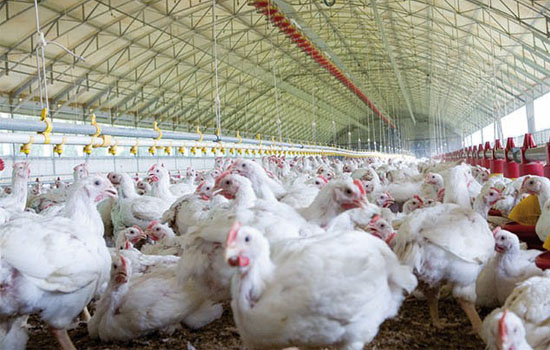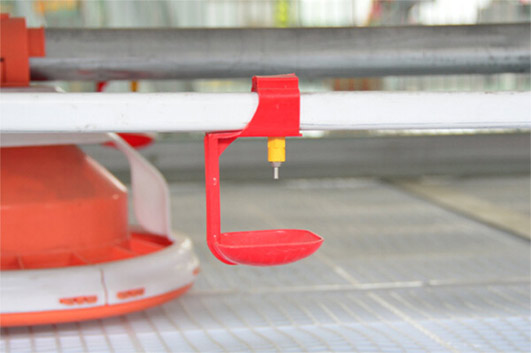The advantages and disadvantages of various ways of raising broilers
- font size
- Be the first to comment!
There are generally three types of broiler rearing: flat rearing, rack rearing and chicken battery cage equipment raise. So what are the advantages and disadvantages of these three methods?

The characteristics of net rearing
1. Grid rearing is better than flat rearing. First of all, net-frame culture keeps the chickens off the ground and avoids contact with ground excrement, which reduces the incidence of colibacillosis and coccidiosis. Secondly, it is convenient to clean the feces of the chicken house, which can effectively reduce labor intensity and labor time.
2. Net-frame breeding is better than cage-raised net-raised broiler chickens. The equipment is simple and the cost is low. Generally, the equipment investment for raising 100 chickens is between 30 and 40 yuan. The investment in cage equipment is calculated at the current market price, and the minimum is 200 yuan. In net-raised chicken, the net surface is softer than the cage, the activity area is open, and the chicken has a large range of activity. The common leg diseases and empyema in broilers are much smaller than in cages.
The main points of net cage culture technology
1. The construction of the chicken coop. It is best to choose a chicken coop far away from the village, with a slightly higher terrain and good ventilation. The houses should not be too low. A house with a too low temperature has poor insulation in winter and poor insulation in summer. There should be skylights on the roof, vents at the roots of the walls, doors and windows should not be too small, and the span of the house should be more than 5 meters.
2, heating up. Temperature is the key to increase the survival rate of broilers. After the chicken house is built, it is best to use land for heating equipment. The fire head of the kang should be built on the side of the gable wall close to the door of the house. After the fire dragon enters the house, it will be divided into left and right forks. It will join together on the other gable wall and be discharged from the chimney outside. The distance between the fire dragon and the left and right walls is about 0.75 to 1.50 meters.
3. The construction of the grid. Chicken nets are generally built about 1 to 1.2 meters above the ground, on both sides of the house, directly above the fire dragon, and a corridor of about 0.5 to 0.75 meters is left in the middle to facilitate work such as cleaning manure, adding food and water. The rack is built with bamboo poles or wooden sticks with a diameter of 2 to 2.5 cm, which can bear the weight of an adult chicken.
4. Preparation before entering the young. To build a new chicken house, simply spray it with disinfectant once. For example, use Baidusha, Sanshiwang, etc. spray. If it is an old chicken house, first clean the equipment of the chicken house carefully, and then spray it with 2% NaOH solution. Then, it is fumigated with potassium permanganate and formaldehyde, and finally with Baidusha spray. After all the disinfection is completed, start to ignite and pre-warm, so that the temperature in the brooding range reaches 32-35℃. The warm-up time depends on the season and the outside temperature. Generally, warm up for 2 to 3 days in winter, 2 days in spring and autumn, and 1 day in summer. Check the thermometer at any time to see if the temperature meets the requirements. Preheat the stove to prevent gas poisoning.
5. Management after entering the young. After entering the chicks, drink water for the chicks first, and add electrolytic multivitamins and glucose in the drinking water to reduce the stress during transportation. The temperature after entering the chicks is the best standard for the comfort of the flock. If the flock is far away from the heat source, and there is the phenomenon of mouth breathing, it indicates that the temperature is high. If the chickens are close to the heat source and crowded together, it indicates that the temperature is low. The chickens are evenly scattered on the edge of the heat source, indicating that the temperature is moderate. Generally, the temperature in the previous week was 32-35°C, and then it would drop by about 3°C every week, and finally 21°C would be more appropriate. Broilers are in a suitable temperature range, and the ideal humidity is about 40-72%. Excessive humidity can induce a variety of diseases such as coccidiosis. Low humidity, increased dust in the air, and respiratory diseases are likely to occur.
Broilers generally use 24 hours of light. If one hour of darkness is given every day, the chickens can adapt to the dark environment. Once the power is cut off, they will not be crowded and suffocated. The principle of light
intensity for broilers is from strong to weak. At 1 to 2 weeks, there should be 2.7 watts of light per square meter. This can help the chicks to familiarize themselves with the environment and fully eat and drink. From the third week, the amount of light was changed to 0.7 to 1.3 watts per square meter. Strong light is harmful to chickens and hinders growth, while weak light can make chickens quiet, which is good for growth and fattening.

Fresh air and proper circulation in the chicken house are prerequisites for raising broilers. Enough oxygen can keep the chickens in good health. Generally, the oxygen content of the chicken house should be kept above 18%. Avoid excessive ammonia in the house. Inhaling too much ammonia will irritate the trachea, cause tracheitis, conjunctivitis, ascites, etc., and increase the chance of coccidiosis infection. , Thereby reducing the conversion rate of feed and causing slow growth.
Regular epidemic prevention can effectively prevent the occurrence of infectious diseases. For example, Newcastle disease, infectious bursal disease, bronchitis, etc., broiler chickens generally use 4 vaccines. In the first week, use H120 to drip the nose, drink the bursal vaccine in the second week, drink H52 in the third week, and use the bursal vaccine again in the fourth week.
By observing the flock, you can know the health status of the flock at any time. Healthy chickens have good spirits, quick reactions, and strong appetites. Unhealthy chickens are sluggish, slow to move, shrink their necks and close their eyes, slow to react, stand out, stand alone, hang down, and have poor spirits. Under normal circumstances, stool has a certain shape, gray-brown, and a certain amount of white substance attached to the surface. If the stool is abnormal, it means that you have been infected with the disease, and you must be diagnosed and treated in time to avoid economic losses
A-Frame layer cages and H-Frame stacked layer cages are both excellent poultry farming battery cages for our customers. Each type of layer farming cages have various tiers and specifications. Tell us your condition of your poultry farming, we will rcommend different plans for you.


